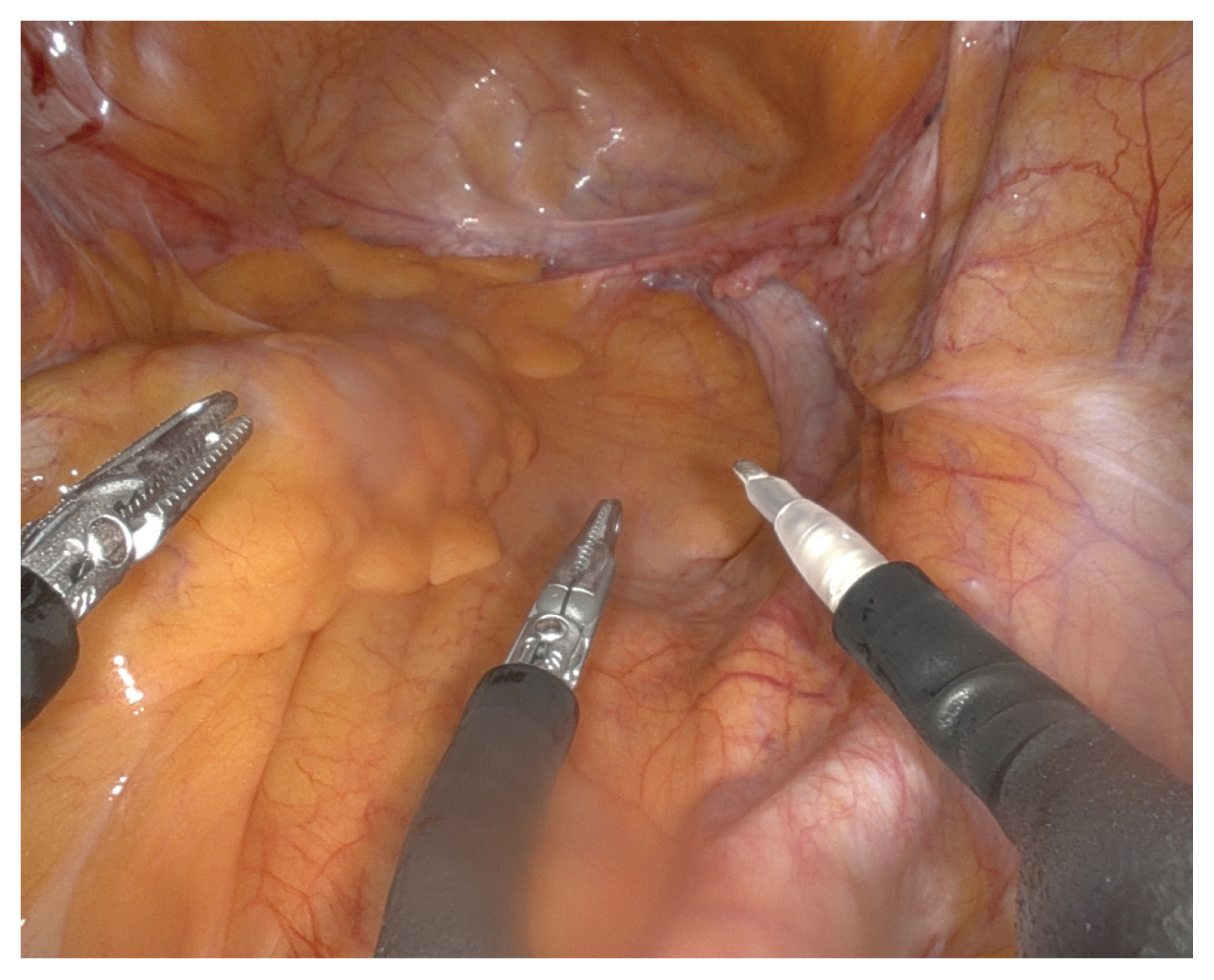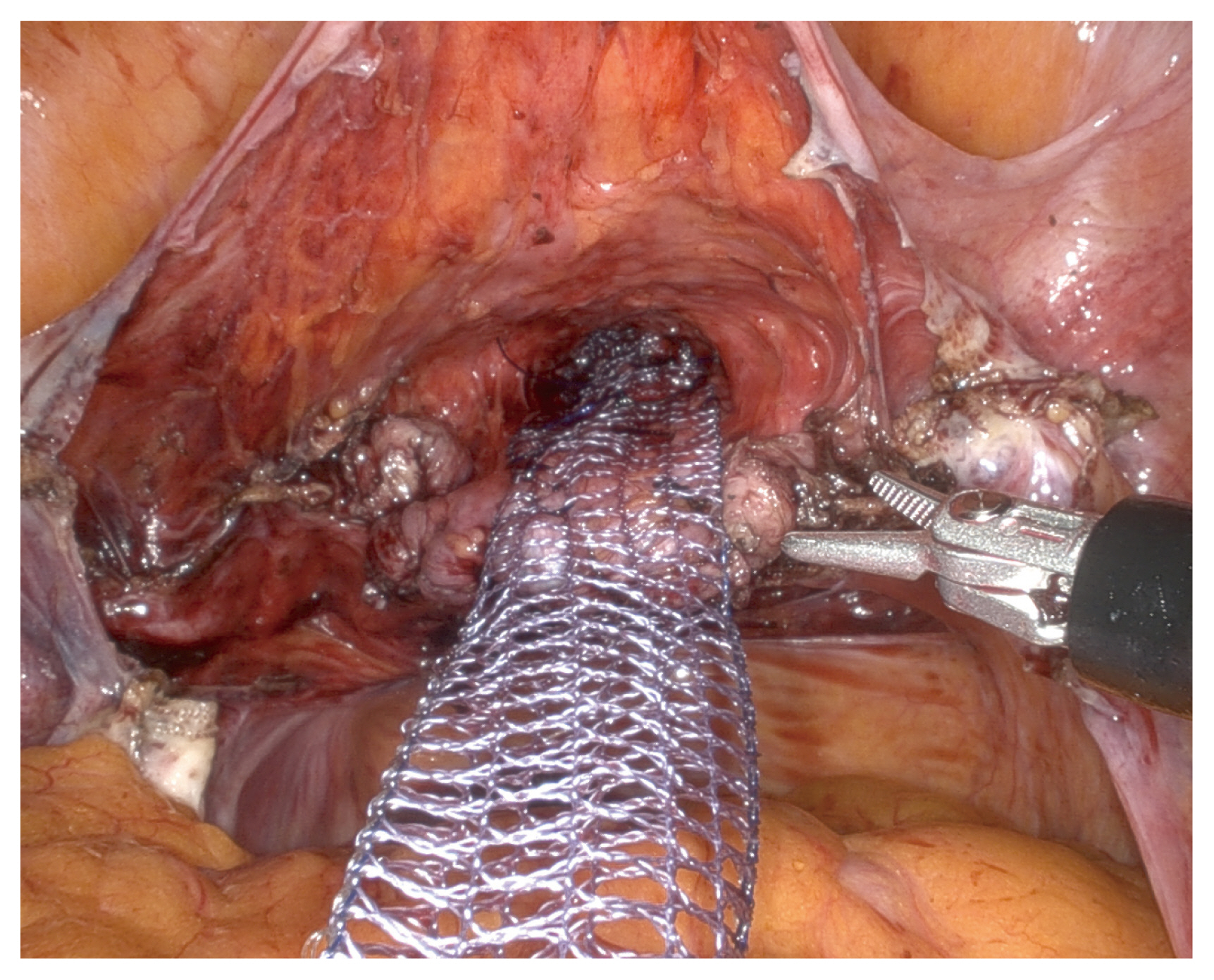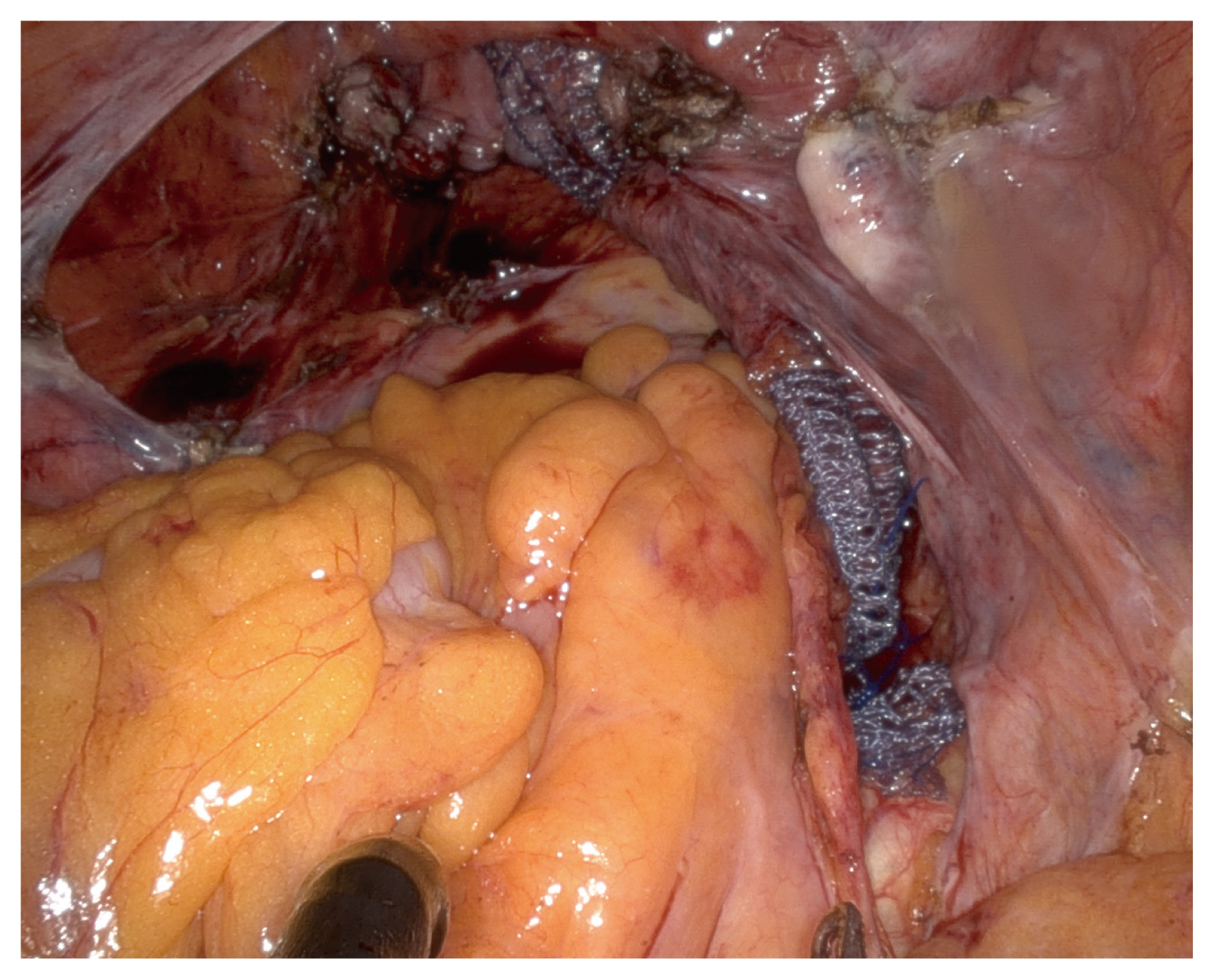Obstet Gynecol Sci.
2023 Nov;66(6):509-517. 10.5468/ogs.23073.
Outcomes of robotic sacrocolpopexy
- Affiliations
-
- 1Department of Obstetrics and Gynecology, Korea University Guro Hospital, Seoul, Korea
- 2Department of Obstetrics and Gynecology, Korea University College of Medicine, Seoul, Korea
- KMID: 2547852
- DOI: http://doi.org/10.5468/ogs.23073
Abstract
- This review aimed to summarize the complications and surgical outcomes of robot-assisted sacrocolpopexy. Nineteen original articles on 1,440 robotic sacrocolpopexies were reviewed, and three systematic reviews and meta-analyses were summarized in terms of intraoperative, perioperative, postoperative, and/or surgical outcomes. Robotic sacrocolpopexy has demonstrated low overall complication rates and favorable surgical outcomes. Nevertheless, long-term follow-up outcomes regarding objective and/or subjective prolapse recurrence, reoperation rates, and mesh-related complications remain unclear. Further research is required to demonstrate whether the robotic approach for sacrocolpopexy is feasible or can become the modality of choice in the future when performing sacrocolpopexy.
Keyword
Figure
Cited by 1 articles
-
Relation between pelvic organ prolapse and menopausal hormone therapy: nationwide cohort study
Hee-Yeong Jung, Tae-Ran Kim, Gwan Hee Han, Jin-Sung Yuk
Obstet Gynecol Sci. 2025;68(3):210-220. doi: 10.5468/ogs.24071.
Reference
-
References
1. Wu JM, Matthews CA, Conover MM, Pate V, Funk MJ. Lifetime risk of stress incontinence or pelvic organ prolapse surgery. Obstet Gynecol. 2014; 123:1201.2. Pelvic organ prolapse: ACOG practice bulletin, number 214. Obstet Gynecol. 2019. 134:e126–42.3. Dällenbach P. To mesh or not to mesh: a review of pelvic organ reconstructive surgery. Int J Womens Health. 2015; 7:331–43.4. Maher C, Baessler K, Glazener CM, Adams EJ, Hagen S. Surgical management of pelvic organ prolapse in women. Cochrane Database Syst Rev. 2007. (4):CD004014.
Article5. Haya N, Baessler K, Christmann-Schmid C, de Tayrac R, Dietz V, Guldberg R, et al. Prolapse and continence surgery in countries of the Organization for Economic Cooperation and Development in 2012. Am J Obstet Gynecol. 2015; 212:755e1–27.
Article6. Nygaard IE, McCreery R, Brubaker L, Connolly A, Cundiff G, Weber AM, et al. Abdominal sacrocolpopexy: a comprehensive review. Obstet Gynecol. 2004; 104:805–23.
Article7. Callewaert G, Bosteels J, Housmans S, Verguts J, Van Cleynenbreugel B, Van der Aa F, et al. Laparoscopic versus robotic-assisted sacrocolpopexy for pelvic organ prolapse: a systematic review. Gynecol Surg. 2016; 13:115–23.
Article8. Moreno Sierra J, Ortiz Oshiro E, Fernandez Pérez C, Galante Romo I, Corral Rosillo J, Prieto Nogal S, et al. Long-term outcomes after robotic sacrocolpopexy in pelvic organ prolapse: prospective analysis. Urol Int. 2011; 86:414–8.
Article9. Gala RB, Margulies R, Steinberg A, Murphy M, Lukban J, Jeppson P, et al. Systematic review of robotic surgery in gynecology: robotic techniques compared with laparoscopy and laparotomy. J Minim Invasive Gynecol. 2014; 21:353–61.
Article10. Serati M, Bogani G, Sorice P, Braga A, Torella M, Salvatore S, et al. Robot-assisted sacrocolpopexy for pelvic organ prolapse: a systematic review and meta-analysis of comparative studies. Eur Urol. 2014; 66:303–18.
Article11. Shin HJ, Yoo HK, Lee JH, Lee SR, Jeong K, Moon HS. Robotic single-port surgery using the da Vinci SP® surgical system for benign gynecologic disease: a preliminary report. Taiwan J Obstet Gynecol. 2020; 59:243–7.12. Matanes E, Lauterbach R, Mustafa-Mikhail S, Amit A, Wiener Z, Lowenstein L. Single port robotic assisted sacrocolpopexy: our experience with the first 25 cases. Female Pelvic Med Reconstr Surg. 2017; 23:e14–8.
Article13. Matanes E, Boulus S, Lauterbach R, Amit A, Weiner Z, Lowenstein L. Robotic laparoendoscopic single-site compared with robotic multi-port sacrocolpopexy for apical compartment prolapse. Am J Obstet Gynecol. 2020; 222:358e1–11.
Article14. Ercoli A, Campagna G, Delmas V, Ferrari S, Morciano A, Scambia G, et al. Anatomical insights into sacrocolpopexy for multicompartment pelvic organ prolapse. Neurourol Urodyn. 2016; 35:813–8.
Article15. Muavha DA, Ras L, Jeffery S. Laparoscopic surgical anatomy for pelvic floor surgery. Best Pract Res Clin Obstet Gynaecol. 2019; 54:89–102.
Article16. Liu J, Bardawil E, Zurawin RK, Wu J, Fu H, Orejuela F, et al. Robotic single-site sacrocolpopexy with retroperitoneal tunneling. JSLS. 2018; 22:e201800009.
Article17. Oh S, Bae N, Cho HW, Park YJ, Kim YJ, Shin JH. Learning curves and perioperative outcomes of single-incision robotic sacrocolpopexy on two different da Vinci® surgical systems. J Robot Surg. 2023; 17:1457–62.18. Hudson CO, Northington GM, Lyles RH, Karp DR. Outcomes of robotic sacrocolpopexy: a systematic review and meta-analysis. Female Pelvic Med Reconstr Surg. 2014; 20:252–60.19. Chan SS, Pang SM, Cheung TH, Cheung RY, Chung TK. Laparoscopic sacrocolpopexy for the treatment of vaginal vault prolapse: with or without robotic assistance. Hong Kong Med J. 2011; 17:54–60.20. Anand M, Woelk JL, Weaver AL, Trabuco EC, Klingele CJ, Gebhart JB. Perioperative complications of robotic sacrocolpopexy for post-hysterectomy vaginal vault prolapse. Int Urogynecol J. 2014; 25:1193–200.
Article21. Paraiso MFR, Jelovsek JE, Frick A, Chen CCG, Barber MD. Laparoscopic compared with robotic sacrocolpopexy for vaginal prolapse: a randomized controlled trial. Obstet Gynecol. 2011; 118:1005–13.22. Culligan PJ, Lewis C, Priestley J, Mushonga N. Long-term outcomes of robotic-assisted laparoscopic sacrocolpopexy using lightweight Y-mesh. Female Pelvic Med Reconstr Surg. 2020; 26:202–6.
Article23. van Zanten F, van Iersel JJ, Paulides TJC, Verheijen PM, Broeders IAMJ, Consten ECJ, et al. Long-term mesh erosion rate following abdominal robotic reconstructive pelvic floor surgery: a prospective study and overview of the literature. Int Urogynecol J. 2020; 31:1423–33.
Article24. Nam G, Lee SR, Roh AM, Kim JH, Choi S, Kim SH, et al. Single-incision vs. multiport robotic sacrocolpopexy: 126 consecutive cases at a single institution. J Clin Med. 2021; 10:4457.
Article25. Lee SR, Roh AM, Jeong K, Kim SH, Chae HD, Moon HS. First report comparing the two types of single-incision robotic sacrocolpopexy: single site using the da Vinci Xi or Si system and single port using the da Vinci SP system. Taiwan J Obstet Gynecol. 2021; 60:60–5.
Article26. Mourik SL, Martens JE, Aktas M. Uterine preservation in pelvic organ prolapse using robot assisted laparoscopic sacrohysteropexy: quality of life and technique. Eur J Obstet Gynecol Reprod Biol. 2012; 165:122–7.
Article27. Fagan Matthew. Preoperative and postoperative complications and management. Alfred EB, Geoffrey WC, Steven ES, editors. Ostergard’s urogynecology and pelvic floor dysfunction. 6th ed. Philadelphia (PA): Lippincott Williams & Wilkins;2008. p. 328–9.28. Matthews CA, Carroll A, Hill A, Ramakrishnan V, Gill EJ. Prospective evaluation of surgical outcomes of robot-assisted sacrocolpopexy and sacrocervicopexy for the management of apical pelvic support defects. South Med J. 2012; 105:274–8.
Article29. Germain A, Thibault F, Galifet M, Scherrer ML, Ayav A, Hubert J, et al. Long-term outcomes after totally robotic sacrocolpopexy for treatment of pelvic organ prolapse. Surg Endosc. 2013; 27:525–9.
Article30. Illiano E, Ditonno P, Giannitsas K, De Rienzo G, Bini V, Costantini E. Robot-assisted Vs laparoscopic sacrocolpopexy for high-stage pelvic organ prolapse: a prospective, randomized, single-center study. Urology. 2019; 134:116–23.
Article31. Anger JT, Mueller ER, Tarnay C, Smith B, Stroupe K, Rosenman A, et al. Robotic compared with laparoscopic sacrocolpopexy: a randomized controlled trial. Obstet Gynecol. 2014; 123:5–12.32. Cundiff GW, Varner E, Visco AG, Zyczynski HM, Nager CW, Norton PA, et al. Risk factors for mesh/suture erosion following sacral colpopexy. Am J Obstet Gynecol. 2008; 199:688.e1–5.
Article33. Deblaere S, Hauspy J, Hansen K. Mesh exposure following minimally invasive sacrocolpopexy: a narrative review. Int Urogynecol J. 2022; 33:2713–25.
Article34. Siddiqui NY, Geller EJ, Visco AG. Symptomatic and anatomic 1-year outcomes after robotic and abdominal sacrocolpopexy. Am J Obstet Gynecol. 2012; 206:435.e1–5.
Article35. Geller EJ, Parnell BA, Dunivan GC. Pelvic floor function before and after robotic sacrocolpopexy: one-year outcomes. J Minim Invasive Gynecol. 2011; 18:322–7.
Article36. Myers EM, Siff L, Osmundsen B, Geller E, Matthews CA. Differences in recurrent prolapse at 1 year after total vs supracervical hysterectomy and robotic sacrocolpopexy. Int Urogynecol J. 2015; 26:585–9.
Article37. Nygaard I, Brubaker L, Zyczynski HM, Cundiff G, Richter H, Gantz M, et al. Long-term outcomes following abdominal sacrocolpopexy for pelvic organ prolapse. JAMA. 2013; 309:2016–24.
Article38. Schulten SF, Detollenaere RJ, IntHout J, Kluivers KB, Van Eijndhoven HW. Risk factors for pelvic organ prolapse recurrence after sacrospinous hysteropexy or vaginal hysterectomy with uterosacral ligament suspension. Am J Obstet Gynecol. 2022; 227:252e1–9.
Article39. Friedman T, Eslick GD, Dietz HP. Risk factors for prolapse recurrence: systematic review and meta-analysis. Int Urogynecol J. 2018; 29:13–21.
Article40. Oh S, Jeon MJ. How and on whom to perform uterine-preserving surgery for uterine prolapse. Obstet Gynecol Sci. 2022; 65:317–24.
Article41. Freeman RM, Pantazis K, Thomson A, Frappell J, Bombieri L, Moran P, et al. A randomised controlled trial of abdominal versus laparoscopic sacrocolpopexy for the treatment of post-hysterectomy vaginal vault prolapse: LAS study. Int Urogynecol J. 2013; 24:377–84.
Article42. Costantini E, Mearini L, Lazzeri M, Bini V, Nunzi E, di Biase M, et al. Laparoscopic versus abdominal sacrocolpopexy: a randomized, controlled trial. J Urol. 2016; 196:159–65.
Article43. Coolen AWM, van Oudheusden AMJ, Mol BWJ, van Eijndhoven HWF, Roovers JWR, Bongers MY. Laparoscopic sacrocolpopexy compared with open abdominal sacrocolpopexy for vault prolapse repair: a randomised controlled trial. Int Urogynecol J. 2017; 28:1469–79.
Article44. Matthews CA, Geller EJ, Henley BR, Kenton K, Myers EM, Dieter AA, et al. Permanent compared with absorbable suture for vaginal mesh fixation during total hysterectomy and sacrocolpopexy: a randomized controlled trial. Obstet Gynecol. 2020; 136:355–64.45. Tan-Kim J, Nager CW, Grimes CL, Luber KM, Lukacz ES, Brown HW, et al. A randomized trial of vaginal mesh attachment techniques for minimally invasive sacrocolpopexy. Int Urogynecol J. 2015; 26:649–56.
Article46. Berger AA, Tan-Kim J, Menefee SA. Anchor vs suture for the attachment of vaginal mesh in a robotic-assisted sacrocolpopexy: a randomized clinical trial. Am J Obstet Gynecol. 2020; 223:258.e1–8.
Article47. Lee SR. Robotic single-site® sacrocolpopexy: first report and technique using the single-site® wristed needle driver. Yonsei Med J. 2016; 57:1029–33.
Article48. Ganesan V, Goueli R, Rodriguez D, Hess D, Carmel M. Single-port robotic-assisted laparoscopic sacrocolpopexy with magnetic retraction: first experience using the SP da Vinci platform. J Robot Surg. 2020; 14:753–8.
Article49. Gupta P, Ehlert M, Bartley J, Gilleran J, Killinger KA, Boura JA, et al. Perioperative outcomes, complications, and efficacy of robotic-assisted prolapse repair: a single institution study of 196 patients. Female Pelvic Med Reconstr Surg. 2018; 24:408–11.
Article50. Thomas TN, Davidson ERW, Lampert EJ, Paraiso MFR, Ferrando CA. Long-term pelvic organ prolapse recurrence and mesh exposure following sacrocolpopexy. Int Urogynecol J. 2020; 31:1763–70.
Article
- Full Text Links
- Actions
-
Cited
- CITED
-
- Close
- Share
- Similar articles
-
- Robotic Sacrocolpopexy for Treatment of Apical Compartment Prolapse
- Robotic sacrocolpopexy
- Robotic Single-Site® Sacrocolpopexy: First Report and Technique Using the Single-Site® Wristed Needle Driver
- Robot-assisted surgery in gynecology: indications and efficacy
- Clinical study of laparoscopic sacrocolpopexy for pelvic organ prolapse





